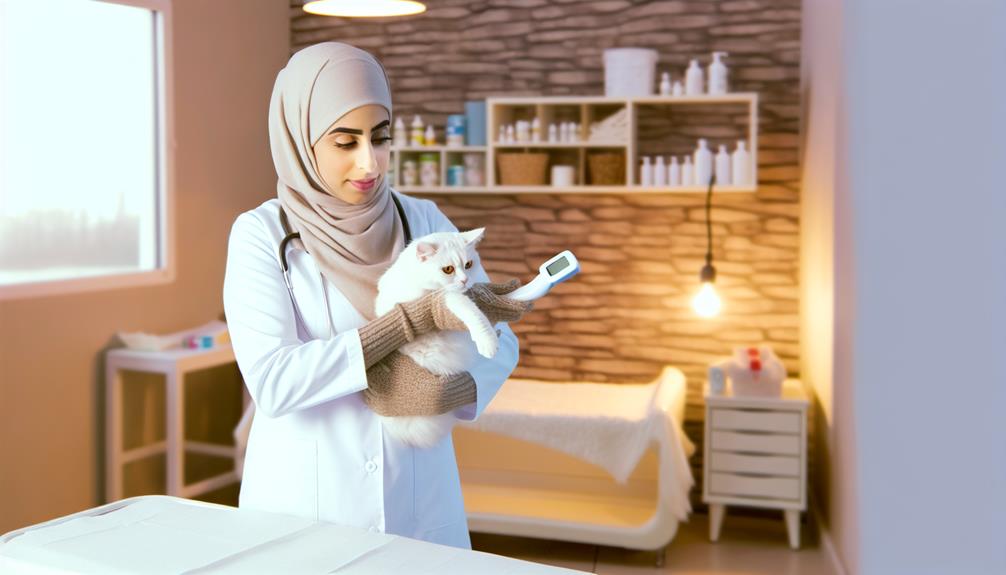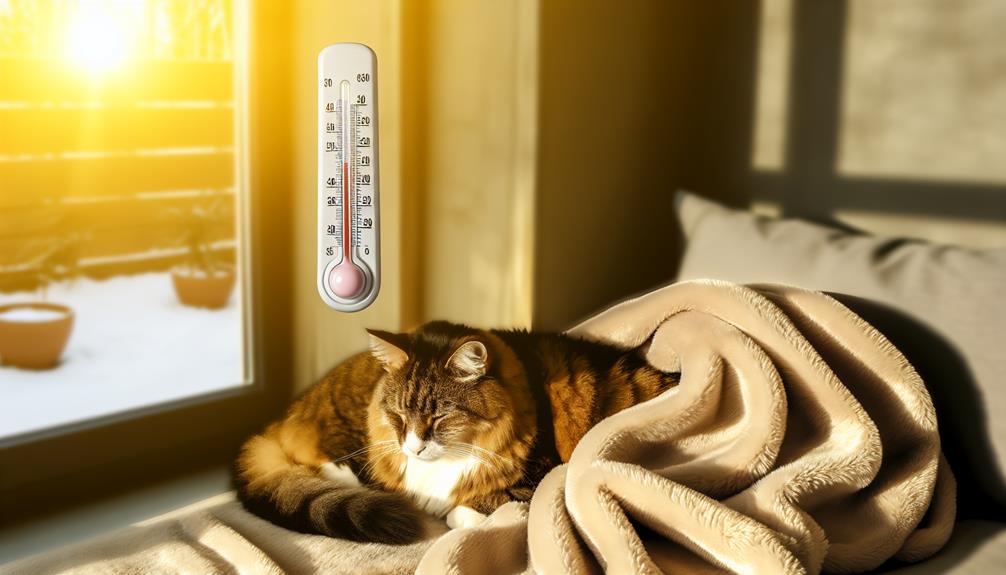When it comes to your feline friend's comfort, ensuring their well-being involves keeping an eye on their normal body temperature. You might be surprised to learn that a healthy cat's temperature typically hovers between 100.5°F to 102.5°F. If it strays from this range, it could be a sign of something amiss. You'll want to know how to measure their temperature accurately and what tools are best for the job. Understanding these details can make a significant difference in your cat's health. So, what should you do if you notice a deviation in their temperature?
Understanding Feline Thermoregulation
Feline thermoregulation is a complex physiological process that maintains a cat's core body temperature within the ideal range of approximately 100.5°F to 102.5°F (38°C to 39.2°C). This process is vital for a cat's survival and overall health, as even minor deviations can indicate underlying health issues or environmental stressors. By understanding the mechanisms behind feline heat and body regulation, you can better monitor and manage your cat's well-being.
Cats utilize both behavioral and physiological strategies to regulate their body temperature. One key aspect of feline heat regulation is vasodilation, where blood vessels expand to increase blood flow to the skin, promoting heat dissipation. Conversely, vasoconstriction reduces blood flow to the body's surface to conserve heat. Additionally, cats engage in grooming behaviors to cool down; the evaporation of saliva from their fur aids in thermal regulation.
Metabolic heat production is another important component of body regulation in cats. Their basal metabolic rate (BMR) generates heat internally, which is essential for maintaining core temperature during cooler conditions. Shivering thermogenesis is a physiological response that generates additional heat through muscle contractions when a cat is exposed to cold temperatures.
Cats also rely on behavioral adaptations to maintain their ideal temperature. Seeking shade, lying on cool surfaces, or spreading out their bodies are common strategies to dissipate excess heat. Conversely, curling up in warm, confined spaces helps retain body heat.
Normal Temperature Range
Your cat's normal temperature range is 100.5 to 102.5 degrees Fahrenheit. Accurate measurement methods include rectal thermometers and ear thermometers. Be alert for signs of fever such as lethargy, loss of appetite, and rapid breathing.
Typical Temperature Range
Typically, a cat's normal temperature range falls between 100.5°F and 102.5°F (38.1°C to 39.2°C). Maintaining this temperature is vital for ideal cat health. Deviations from this range can indicate underlying health issues or environmental stressors. Temperature fluctuations, even minor ones, may warrant further investigation.
Here's a breakdown of temperature ranges and their implications:
| Temperature (°F) | Temperature (°C) | Implications |
|---|---|---|
| Below 100.5°F | Below 38.1°C | Hypothermia: potential cold stress or illness |
| 100.5°F – 102.5°F | 38.1°C – 39.2°C | Normal: ideal health |
| 102.6°F – 103.5°F | 39.3°C – 39.7°C | Mild fever: possible infection or inflammation |
| 103.6°F – 104.5°F | 39.8°C – 40.3°C | Moderate fever: likely infection, vet advised |
| Above 104.5°F | Above 40.3°C | Severe fever: medical emergency |
Monitoring your cat's temperature within this range is essential for early detection of health anomalies. Hypothermia and hyperthermia can both pose significant risks. Should your cat's temperature fall outside the typical range, it's vital to consult a veterinarian promptly. This vigilance guarantees that temperature fluctuations are addressed before they escalate into serious health issues.
Measuring Temperature Methods
Accurately measuring a cat's temperature is vital for appraising its health. The most reliable method is via a rectal thermometer, providing a precise reading of your cat's core temperature. For your feline, the normal range is 100.5 to 102.5 degrees Fahrenheit. It's important to detect any temperature fluctuations early, as they can indicate underlying issues affecting feline health.
To measure rectally, use a digital thermometer designed for pets. Lubricate the tip with petroleum jelly, then gently insert it one inch into the rectum. Hold the thermometer in place until it beeps, then carefully remove and read the display. This method guarantees an accurate evaluation of your cat's thermal state.
Alternatively, ear thermometers are less invasive but can be less accurate. They measure the infrared heat waves from the eardrum, but improper technique or ear issues can skew results. Confirm the thermometer is correctly positioned in the horizontal ear canal for consistency.
Never rely on nose or paw temperature as indicators; they're unreliable for evaluating core temperature. Regular monitoring using these precise methods helps you promptly address any deviations, safeguarding your cat's overall health.
Signs of Fever
Recognizing the signs of fever in your cat is imperative following temperature measurement. A normal feline body temperature ranges from 100.5°F to 102.5°F. When your cat's temperature exceeds this range, it indicates hyperthermia, commonly known as fever. Fever causes in cats include infections, inflammation, and immune-mediated diseases. Identifying early symptoms can streamline fever treatment and prevent complications.
Common signs of fever in cats include lethargy, decreased appetite, and dehydration. Additionally, you might observe rapid breathing, shivering, and a higher heart rate. If your cat exhibits these symptoms, immediate veterinary consultation is advised.
| Symptom | Description | Normal Range |
|---|---|---|
| Temperature | Above 102.5°F | 100.5°F – 102.5°F |
| Appetite | Decreased or absent | Normal eating patterns |
| Hydration | Signs of dehydration | Adequate water intake |
| Respiration | Rapid or labored breathing | 20-30 breaths per minute |
| Heart Rate | Elevated pulse rate | 140-220 beats per minute |
Understanding these signs allows for timely intervention. Effective fever treatment may involve antibiotics for bacterial infections or anti-inflammatory drugs for other causes. Always follow veterinary guidance to guarantee your cat's health and well-being.
Measuring Your Cat's Temperature

Measuring your cat's temperature accurately requires the use of a digital rectal thermometer, as it's the most reliable method available. This process, while perhaps uncomfortable for both you and your feline friend, is crucial for monitoring cat temperature fluctuations, which can indicate underlying health issues. An adult cat's normal temperature ranges between 100.5°F and 102.5°F. Deviations from this range necessitate immediate attention.
To measure your cat's temperature, follow these steps precisely:
- Preparation: Gather a digital rectal thermometer, lubricant, and a clean cloth. Confirm your cat is calm and restrained gently.
- Lubrication: Apply a small amount of lubricant to the thermometer's tip to ease insertion.
- Insertion: Gently lift your cat's tail and insert the thermometer about one inch into the rectum. Hold it steady until it beeps.
- Reading: Remove the thermometer and record the temperature reading immediately.
Understanding the significance of monitoring your cat's temperature cannot be overstated. Cat temperature fluctuations can be symptomatic of infections, inflammations, or other medical conditions that require prompt veterinary intervention.
It's critical to maintain a calm demeanor throughout the process to minimize stress for your cat. Regular monitoring is advisable, especially if your cat is showing signs of illness or discomfort. Remember, accurate temperature measurement is crucial for effective diagnosis and treatment.
Tools for Temperature Measurement
When measuring your cat's temperature, you'll primarily use digital thermometers, which offer quick and accurate readings. Ear thermometers can be less reliable due to anatomical variations, whereas rectal thermometers provide precise measurements, typically between 100.5°F and 102.5°F. Make certain you follow proper rectal temperature procedure to avoid discomfort and obtain the most accurate result.
Digital Thermometers for Cats
Although traditional thermometers have been used for years, digital thermometers offer a more accurate and convenient method for measuring a cat's body temperature. With precise digital thermometer features, you can guarantee that your cat's health is monitored with the utmost accuracy.
When choosing thermometer brands, consider these critical factors:
- Response Time: Digital thermometers provide instantaneous readings, typically within 10-30 seconds, minimizing stress for your cat.
- Accuracy: Modern digital thermometers have an error margin as low as ±0.1°C, guaranteeing precise measurements.
- Ease of Use: Look for models with ergonomic designs and easy-to-read LCD screens for quick interpretation of results.
- Memory Function: Some digital thermometers can store previous readings, allowing you to track temperature changes over time.
To guarantee you're selecting the best device, explore well-known brands like Braun, iProven, and Kinsa, which are renowned for their reliability and user-friendly interfaces. By investing in a high-quality digital thermometer, you're not just buying a gadget; you're safeguarding your pet's well-being with advanced technology. Always refer to the manufacturer's guidelines for calibration and proper usage to maximize the device's lifespan and accuracy.
Ear Thermometers Accuracy
Ear thermometers provide a non-invasive, quick, and precise method for gauging your cat's body temperature. These devices use infrared technology to measure the heat emitted from the eardrum and surrounding tissue. Given the delicate nature of a cat's ear canal, using an ear thermometer can be less stressful than other methods. However, accuracy is dependent on several factors, including the type of ear thermometer and proper calibration.
There are various ear thermometer types, such as digital infrared ear thermometers and thermocouple ear thermometers. Digital infrared units are generally preferred due to their high accuracy and ease of use. Regardless of type, maintaining proper ear thermometer calibration is vital for reliable readings. Calibration guarantees that the device provides measurements within a narrow margin of error, typically ±0.1°C.
For peak performance, you should regularly check and calibrate your ear thermometer according to the manufacturer's guidelines. Calibration involves comparing the thermometer's readings against a known temperature standard and making necessary adjustments. In veterinary practice, accuracy is paramount; even minor deviations can lead to misdiagnosis. Therefore, investing in a high-quality, well-calibrated ear thermometer is essential for maintaining your cat's health.
Rectal Temperature Procedure
While ear thermometers offer a non-invasive method for measuring your cat's temperature, rectal thermometers remain the gold standard for accuracy in veterinary practice. To guarantee you get a precise reading, follow these steps closely.
First, gather your tools:
- Digital rectal thermometer: Preferred for quick, accurate readings.
- Lubricant: To minimize discomfort and reduce temperature sensitivity.
- Alcohol wipes: For sterilizing the thermometer before and after use.
- A second person: To help hold your cat securely.
Position your cat on a stable surface. Pay attention to cat body language; signs of stress may indicate the need for a break. Gently insert the lubricated thermometer into the rectum, approximately one inch deep. Hold it steadily until the thermometer beeps, indicating the measurement is complete. Aim for a normal range of 100.5°F to 102.5°F.
Always sterilize the thermometer after use to maintain hygiene. If your cat shows extreme temperature sensitivity or unusual cat body language, consult your veterinarian. Accurate temperature measurement is essential for detecting health issues early, safeguarding your cat's well-being.
Signs of Temperature Issues

When monitoring your cat's health, recognizing signs of temperature issues is vital. Cats typically have a normal body temperature ranging between 100.5°F to 102.5°F. Deviations from this range can indicate underlying health problems. Fever symptoms are important to identify; they include lethargy, decreased appetite, and shivering. Additionally, temperature fluctuations—either hypothermia or hyperthermia—pose considerable risks and require immediate attention.
Common Signs of Temperature Issues
| Symptom | Likely Condition |
|---|---|
| Lethargy | Fever |
| Shivering | Fever or Hypothermia |
| Decreased Appetite | Fever |
Lethargy is often the first noticeable sign of temperature irregularities. If your cat is unusually inactive or shows reluctance to engage in normal activities, it might be experiencing a fever. Alongside lethargy, shivering is another symptom indicative of fever or hypothermia. It's essential to differentiate between these conditions, as the required interventions diverge notably.
Decreased appetite is another key symptom to monitor. Cats with elevated temperatures often show reduced interest in food. This symptom, when coupled with lethargy and shivering, strongly suggests a fever. Observing these signs promptly will guide you in determining whether your cat's temperature is within the normal range or if there are fluctuations that necessitate veterinary consultation.
Quick Reference for Action
| Symptom | Immediate Action |
|---|---|
| Lethargy | Check temperature |
| Shivering | Evaluate for fever/hypothermia |
| Decreased Appetite | Monitor and consult vet |
Understanding these signs empowers you to take timely actions, ensuring your cat's health and well-being. Detecting temperature issues early can prevent more severe complications and facilitate prompt medical intervention.
Steps to Take if Temperature Deviates
Recognizing the signs of temperature issues in your cat is just the beginning; knowing the steps to take if their temperature deviates is the next vital phase. Accurate temperature monitoring is paramount, as a cat's normal body temperature ranges between 100.5°F and 102.5°F. Any deviation can indicate underlying health issues that require immediate attention.
Begin by confirming the deviation through precise temperature monitoring using a reliable digital rectal thermometer. If your cat's temperature is below 99°F or above 103°F, take the following steps:
- Contact Your Veterinarian Immediately: Inform them of the exact temperature reading and any accompanying symptoms. Rapid professional intervention is essential for fever management or hypothermia treatment.
- Maintain Hydration: Make certain your cat stays hydrated. Offer water frequently or use an electrolyte solution specifically designed for pets, as dehydration can exacerbate temperature irregularities.
- Regulate Environment: If your cat is hypothermic (temperature below 99°F), provide a warm environment using blankets or a heating pad set to a low temperature. Conversely, if your cat has a fever (temperature above 103°F), a cool environment is necessary. Use fans or cool, damp cloths to help lower their body temperature gradually.
- Monitor Closely: Continue to monitor their temperature every 30 minutes to an hour. Document all changes and responses to any interventions. Consistent temperature monitoring helps in gauging the effectiveness of your actions and provides valuable information for your veterinarian.
Conclusion
Maintaining your cat's normal temperature, between 100.5°F and 102.5°F, is paramount. Just as a well-tuned engine guarantees a car's performance, your vigilant monitoring can safeguard your cat's health. Use precise tools like digital thermometers and heed any deviations. Hypothermia or fever are not just numbers; they're signals demanding swift action. Stay proactive, and you'll guarantee your feline friend remains in peak condition, ready to purr contentedly by your side.
